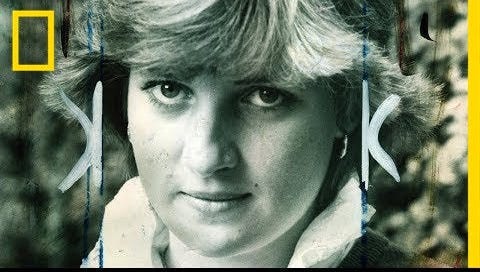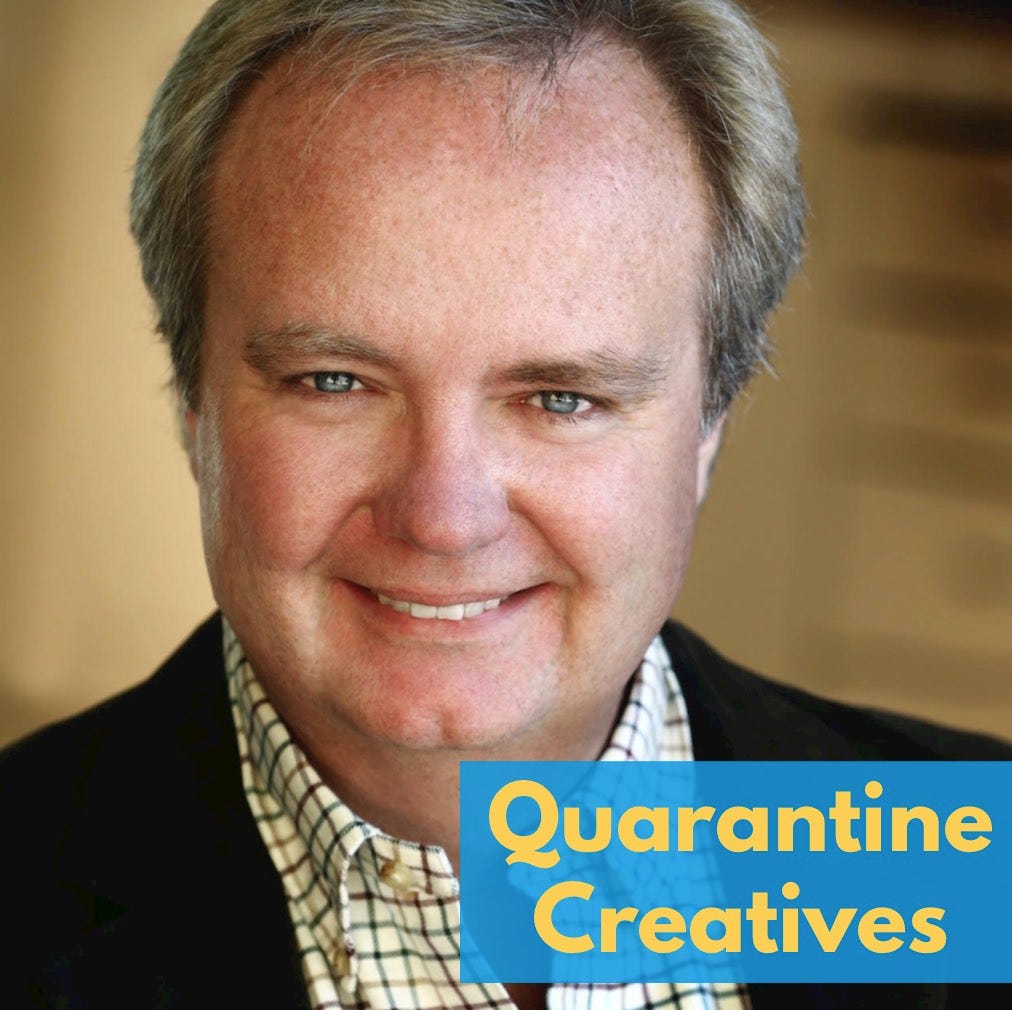Welcome to the Quarantine Creatives newsletter, a companion to my podcast of the same name. If you enjoy what you’re reading, you can subscribe to have this newsletter in your inbox every Sunday:
Right Under My Nose
I feel like one of the themes of this week’s show, and perhaps this past week in general, is being on the lookout for something special that you don’t know is there. It might be completely hidden away and require some digging, or in my case, it might have been right under my nose the whole time.
If you follow me on Instagram, you have seen some of my mushroom growing attempts over the last few months. My friend Elizabeth over at Fat Moon Mushrooms started creating mushroom grow kits and I have been using one of them to grow my own shiitake mushrooms. I love having fresh mushrooms available, and the only care they need is a good soaking a few times a day. (If you’re interested in growing your own, Elizabeth ships the grow kits around the country and you can use promo code HEATH to save $10 off a kit!)
Well, imagine my surprise when I spotted what appeared to be a morel in my own backyard this past week!
I had never foraged for them. In fact, I’d never even tasted one before, so I have been learning a ton over this last week. If you don’t know, morels are a highly sought after mushroom that is nearly impossible to cultivate, so they have to be found in the wild. They only appear in the springtime and are difficult to store and transport. Basically, in order to taste them, you either have to know a forager or be a forager.
Had I not been paying attention, I likely wouldn’t have even noticed them at all, or worse, knocked them over thinking them a nuisance or pest.
Instead, they stood out to me, spoke to me, and I discovered nearly 15 of them! That’s the photo of them from this past Tuesday. My wife cooked them into a delicious, creamy pasta sauce and we enjoyed a surprise dinner that a few hours earlier we never would have expected to eat.
The answers to what we seek are out there. They may not always be where we expect them or even what we thought they would be, but they’re there. Pay attention and be ready for them when they appear!
Episode 84- Tom Jennings
Last week, I had a really fascinating conversation with documentary filmmaker Tom Jennings. Tom has developed a unique storytelling style where his films do not rely on any voiceover narration or newly produced interviews. Every element contained in the film is contemporary to the story he is telling. His latest project is The Real Right Stuff, which looks at the first Mercury astronauts for Disney+. Here’s the trailer:
Tom’s films have covered major events from the 1950s through today, though they all take a similar approach and require extensive research to find footage that has never seen before. Tom explained to me how his style of documentary filmmaking was unknowingly refined during his prior career:
“I used to be a newspaper reporter, that’s what my training was. Back when I learned to be a reporter, what our professors hammered into our heads was the beauty of research and how to find things. And so when I transferred over to doing documentary television in the mid to late 90s, I took those skills with me.”
While many documentarians rely on large archive houses, Tom encourages his team to dig deeper, which give his films a “new” feel. He told me what he tells new hires when he’s training them on his way of working:
“Just don’t go to the usual suspects, you have to think outside the box. You have to be willing to remember that not everything in the world is on the internet. You have to pick up the phone and call people. If someone says I don’t have anything like that, you always have to follow up and say Do you know anyone in town that might? And sure enough, one name leads to another, it’s just like being a reporter. You’re just seeking something out that you think may exist. If you can think that a piece of archive exists, it probably does. There’s probably somebody out there that has it”
A big source of footage comes from local news archives. However, this can be problematic because news stations are often not set up to archive well. After all, their focus is usually on getting several newscasts on the air daily under immense pressure. Tom told me about the challenges of working with news stations to uncover footage:
“What we find is probably 80% of the local affiliates that we’ve ever contacted have not kept their footage, even from major events. The reason being it was too cumbersome, it took up too much room. When the new video tape came along, it was very expensive, and so they would take whatever they wanted from that day and then they would tape over it four to five times until they couldn’t use it anymore. There was a lot of history that was lost that way. But eight out of ten didn’t keep their stuff, there’s two that did, and it’s always our job to find them.”
Sometimes telling a story requires creative problem solving. Because films are a visual medium, many filmmakers think in visual terms (I know I do). But Tom has learned that there can be other great sources of material that can help tell his story, even if a local TV news station isn’t able to help:
“We put together a story with all the media we can get our hands on, and that includes an often forgotten vein of wonderful archive, which is radio. Radio is theatre of the mind. So if you have footage and stills and then you get a great radio reporter who can talk while you’re playing that stuff, there’s real magic in that.”
The one original element in all of Tom’s films is music. Because he can’t control the tone of the footage or dialogue, music is where the creative storytelling really comes into play. Tom has partnered on several projects with iconic composer Hans Zimmer and his studio to create custom scores for his documentaries. (If you don’t know, Hans is behind some of the biggest scores in Hollywood, including The Lion King, Gladiator, and the Pirates of the Caribbean series). Tom shared some amazing insights into working with Hans during the full interview, though they are too lengthy to recount in a newsletter. You’ll just have to take a listen!
One of Tom’s other high profile projects is the documentary Diana: In Her Own Words. It was first produced for the 20 year anniversary of her death, but saw a big surge last year when Netflix offered it alongside The Crown Season Four (the documentary is now streaming on Disney+). Here’s the trailer:
The film is unique in that it is told entirely by Princess Diana from secret recordings that became the basis for Andrew Morton’s explosive 1992 book Diana: Her True Story. Andrew had only disclosed the existence of these tapes after Diana’s death, but they had never been heard publicly.
Tom approached Andrew about the tapes and requested permission to use them in his film, and was surprised when Andrew agreed to a meeting. Perhaps it was the backing of National Geographic or Tom’s unique approach that didn’t rely on any narration or interviews, but he was able to convince Andrew that this project was the right one for making the tapes public.
If you listen to the whole interview, Tom goes deep into what those negotiations looked like and how he made his pitch, but he summarized the whole experience this way:
“Lightning struck. You don’t get that kind of archival material, regardless of what you think of Diana and her life, she was such a revered figure in so many ways, but she was also the most photographed woman in the world and probably still is.”
Having told historical stories that span the last 70 years or so, I was really curious what Tom’s favorite era is, whether because of the stories he can tell or the footage that is available. Here’s what he had to say:
“For me, the 60s and the 70s are my favorite eras to tell stories, maybe the first part of the 80s as well. The reason for that is I was alive during much of that time. One of the rules that we talk about at my company, for people that are old enough to have been around during some of these events, is: what did I miss, what did I forget, what have I never seen?”
As I’ve mentioned above, the full interview is really loaded with some great stories, most too long to succinctly summarize in this newsletter format. I highly recommend taking the time to listen to the show, especially if you’re a history fan or a documentarian.
What’s Next
Believe it or not, I am now at the one year mark of this podcast. It was launched last May with my very first interview with actor Scott Foley. At the time, I had no idea how long this pandemic would last, how long the show would last, or the direction that it might take.
On Thursday, I will be releasing a special anniversary show- Scott Foley: One Year Later. Scott will be back on the show and we’ll have a candid conversation about the past year. Since we last spoke, he moved his family from California to Connecticut through an RV road trip across the USA, filmed a new reality competition show for HBOMax that’s all about furniture design, and acted in a pilot for Fox that took more than a year of production because of COVID. It’s a relaxed and fun conversation, marking a year of this podcast but also 14+ months of staying home. I hope you’ll tune in!
If you have questions, comments, thoughts, ideas, or anything else that you’d like to share, please feel free to email me anytime: hracela@mac.com
If you’re an Apple Podcasts user, please consider leaving a rating or review for Quarantine Creatives. It only takes a minute, but it helps bring in new listeners. New episodes are released every Thursday- please subscribe!
And please consider sharing this with a friend that you think might enjoy reading this, or better yet, share it on social media so you can tell hundreds of friends!
If you’ve missed past issues of this newsletter, they are available to read here.
Stay Safe!
Heath






